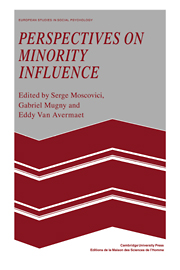Book contents
- Frontmatter
- Contents
- Contributors
- Preface
- Part I The process of minority influence
- Part II Minority influence in groups
- Introduction
- 6 Innovation and socialisation in small groups
- 7 When and how the minority prevails
- 8 The paradox of ‘orthodox minorities’: when orthodoxy infallibly fails
- 9 Conformity, innovation and the psychosocial law
- 10 Infra-group, intra-group and inter-group: construing levels of organisation in social influence
- References
- Subject index
- Author index
Introduction
Published online by Cambridge University Press: 05 February 2012
- Frontmatter
- Contents
- Contributors
- Preface
- Part I The process of minority influence
- Part II Minority influence in groups
- Introduction
- 6 Innovation and socialisation in small groups
- 7 When and how the minority prevails
- 8 The paradox of ‘orthodox minorities’: when orthodoxy infallibly fails
- 9 Conformity, innovation and the psychosocial law
- 10 Infra-group, intra-group and inter-group: construing levels of organisation in social influence
- References
- Subject index
- Author index
Summary
Whereas the first part of this book directly addresses fairly specific questions about the nature of minority influence processes, Part II is much broader in scope. It reflects the views of social psychologists who – at least until recently – were themselves not actively engaged in research in this area but who had the courage and the creativity to look at their own domain of interest through the perspective of minority influence. The products of their, at times speculative, endeavours constitute a worthwhile addition to the field because they force us back to very fundamental questions about the relationship between minority influence, group functioning and group processes in general. As such, the chapters of Part II truly put minority influence in perspective.
Observing that past research concerning small group processes has largely neglected the mutual influence groups and their members have on each other, and that it has not given sufficient attention to the temporal changes that occur in their relationship, John Levine and Richard Moreland present in chapter 6 a new model of group socialisation that does incorporate these two features. They view an individual's passage through a group as a series of phases, each characterised by a different relationship between the group and the individual. Within each phase the group and the individual evaluate one another in terms of their rewardingness.
- Type
- Chapter
- Information
- Perspectives on Minority Influence , pp. 139 - 142Publisher: Cambridge University PressPrint publication year: 1985



